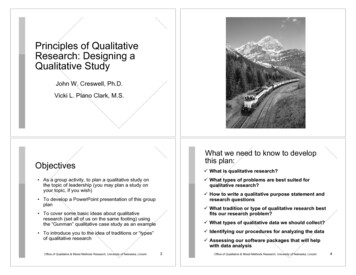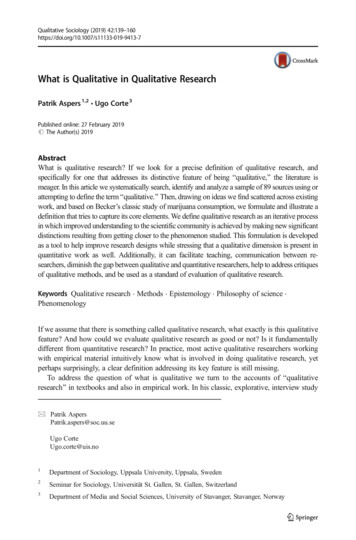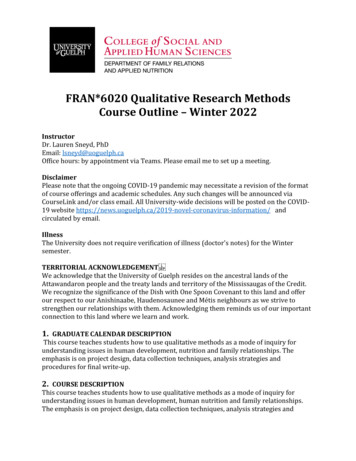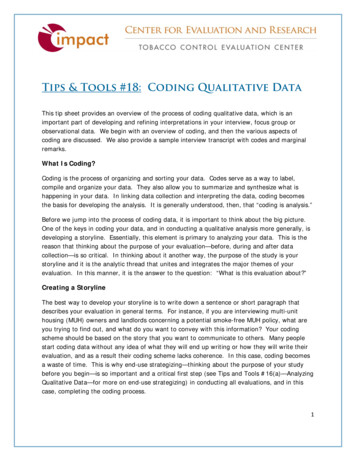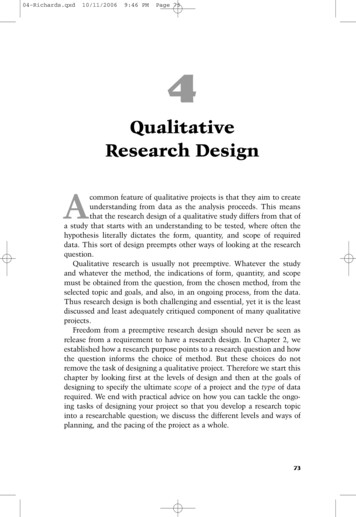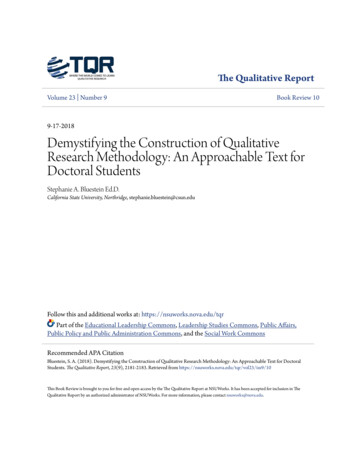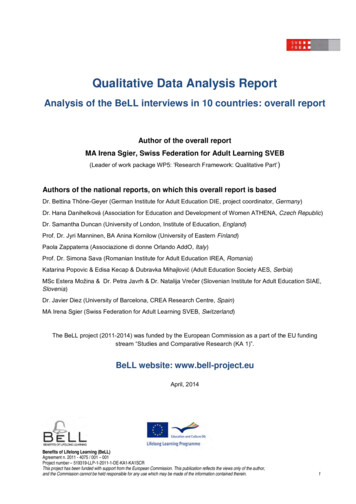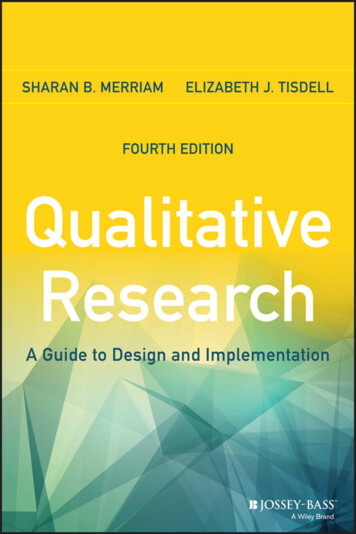
Transcription
http://www.diva-portal.orgThis is the published version of a paper published in .Citation for the original published paper (version of record):Schimmer, R., Orre, C., Öberg, U., Danielsson, K., Hörnsten, Å. (2019)Digital Person-Centered Self-Management Support for People With Type 2 Diabetes:Qualitative Study Exploring Design ChallengesJMIR Diabetes, 4(3): 1-10https://doi.org/10.2196/10702Access to the published version may require subscription.N.B. When citing this work, cite the original published paper.Permanent link to this version:http://urn.kb.se/resolve?urn urn:nbn:se:umu:diva-163461
JMIR DIABETESSchimmer et alOriginal PaperDigital Person-Centered Self-Management Support for PeopleWith Type 2 Diabetes: Qualitative Study Exploring DesignChallengesRobyn Schimmer1, MSc; Carljohan Orre2, PhD; Ulrika Öberg3, RN, PhD; Karin Danielsson1, PhD; Åsa Hörnsten3,RN1Department of Informatics, Umeå University, Umeå, Sweden2Department of Computer Science and Media Technology, Malmö University, Malmö, Sweden3Department of Nursing, Umeå University, Umeå, SwedenCorresponding Author:Robyn Schimmer, MScDepartment of InformaticsUmeå UniversityMIT BuildingUmeå, 90187SwedenPhone: 46 733834222Email: robyn.schimmer@umu.seAbstractBackground: Self-management is a substantial part of treatment for patients with type 2 diabetes (T2D). Modern digitaltechnology, being small, available, and ubiquitous, might work well in supporting self-management. This study follows theprocess of developing a pilot implementation of an electronic health (eHealth) service for T2D self-management support inprimary health care. The use of digital health, or eHealth, solutions for supporting self-management for patients with T2D isincreasing. There are good examples of successful implementations that can serve as guides in the development of new solutions.However, when adding person-centered principles as a requirement, the examples are scarce.Objective: The objective of this study was to explore challenges that could impact the design of a person-centered eHealthservice for T2D self-management support. The study included data collection from multiple sources, that is, interviews, observations,focus groups, and a Mentimeter (interactive presentation with polling) survey among stakeholders, representing various perspectivesof T2D.Methods: A user-centered design approach was used to exploratively collect data from different sources. Data were collectedfrom a workshop, interviews, and observations. The different data sources enabled a triangulation of data.Results: Results show that user needs related to an eHealth service for person-centered T2D self-management support aremultifaceted and situated in a complex context. The two main user groups, patients and diabetes specialist nurses, express needsthat both diverge and converge, which indicates that critical design decisions have to be made. There is also a discrepancy betweenthe needs expressed by the potential users and the current work practice, suggesting more attention toward changing the organizationof work to fully support a new eHealth service.Conclusions:A total of three overarching challenges—flexible access, reducing administrative tasks, and patientempowerment—each having a significant impact on design, are discussed. These challenges need to be considered and resolvedthrough careful design decisions. Special attention has to be given to the patient user group that could greatly impact current workpractice and power structures at the primary care unit. A need for further studies investigating patient needs in everyday life isidentified to better support the implementation of technology that does not give specific attention to organizational perspectivesbut instead approach design with the patient perspective in focus.(JMIR Diabetes 2019;4(3):e10702) doi: 10.2196/10702KEYWORDSeHealth; diabetes mellitus, type 2; informatics; nursing; patient-centered care; 702/XSL FORenderXJMIR Diabetes 2019 vol. 4 iss. 3 e10702 p. 1(page number not for citation purposes)
JMIR DIABETESSchimmer et alIntroductionIt is, therefore, hard to determine the factors that have impacton social support.BackgroundPerson-Centered Care and Electronic HealthUsing electronic health (eHealth) services as self-managementsupport for people with type 2 diabetes (T2D) is, in many ways,a promising way to reduce costs, increase availability of care,and empower patients [1-3]. T2D is a common diagnosis anddemands a high level of self-management. In Sweden, 4% to6% of the population is estimated to suffer from diabetes,although approximately 4% is diagnosed and whereofapproximately 90% is T2D [4,5]. However, as most people arediagnosed at an age of 60 years and above, the prevalence ofT2D is much higher in the older age groups [6]. In the groupof people aged 65 years and older, the prevalence is reportedto be approximately 12% to 18%, with higher percentage amongmen [7]. The illness is complex and demanding as the basictreatment is dietary changes and increased physical activitybesides the pharmaceutical treatment and blood sugar testing.It also commonly involves comorbidities such as hypertension,hyperlipidemia, and obesity and leads to severe complicationssuch as stroke and heart disease, kidney dysfunction, blindness,and other problems if not sufficiently treated and self-managedby patients [8].The American Diabetes Association recommends [8] thatperson-centered care (PCC) approaches should be applied inself-management support. There are benefits of adding PCCfunctionality to eHealth services, both for patients and healthcare organizations [15]. Digital devices that capture personaldata and behaviors can be utilized to develop more personalizedand timely services [16]. However, going through currentliterature, there are still few examples of eHealth services forT2D self-management support that also incorporate PCC.Wildevuur et al [17] present a set of preconditions forinformation and communications technology–enabled PCC andalso conclude that this is a relatively new research area. Theyalso point out the need for more research on design oftechnology that integrates a person-centered approach withattention to the context of use and user experience.The context of this paper is Swedish primary health care, whichis responsible for treating people with T2D. Basic medicaltreatment as well as nursing, prevention, and rehabilitation thatdo not demand special competences are offered in primary healthcare. Patients with chronic illnesses as T2D visit the primaryhealth care center on a regular basis. General practitioners,primary health care nurses with special responsibility fordiabetes clinics, physiotherapists, and occupational therapistsoften work in teams at primary health care centers. Majority ofthem are connected to the public health welfare program.Studies have shown that patients see a potential in using eHealthservices to support self-management [9,10]. The developmentof such eHealth services has been ongoing for many years andwith various outcomes. In a systematic review from 2013, Palet al [11] show that although internet-based interventions fordiabetes self-management have limited effects on glycemiccontrol, mobile phone–based interventions demonstrated morepromising results. In a more recent study, Murray et al [12]report improvements in glycemic control through a Web-basedself-management program.The variety of outcomes reported in different studies implies achallenge in how eHealth services for self-management supportshould be designed, implemented, and evaluated. Reviewingthe supply of available apps for diabetes management, Huanget al [13] conclude that “apps could play an important role incomplementing multifaceted diabetes care” and also highlightthe importance of being context-specific and adaptive to specificuser’s needs. When addressing, for example, specific contextand user needs, it is important to clearly describe how theseperspectives are applied in design and implementation processes.Discussing the potential of self-management eHealthinterventions for social support, Vorderstrasse et al [14]conclude that many studies lack detailed descriptions about howsocial support has been designed, implemented, and SL FORenderXIn this paper, we address these challenges related to design andtechnology for PCC. Design of eHealth services, as with allinformation technology (IT), is not a matter of solving simpleproblems but rather finding a possible composition that meetsthe requirements. Exploring challenges faced in a designsituation of an eHealth service that includes PCC principles is,therefore, crucial for future work integrating them into thedesign of new eHealth services. The study is a part of our workwith an ongoing pilot implementation study to develop aperson-centered eHealth service for T2D self-managementsupport. The aim of this study was to explore possible challengesthat could impact the design of a person-centered eHealth servicefor T2D self-management support in Swedish primary healthcare.MethodsGeneral ApproachThis particular study is part of a larger project with the aim ofexploring the prerequisites for and developing a person-centeredeHealth service for support of self-management in T2D. Theproject has already published several part studies [10,18,19].In this study, data are collected from multiple sources, that is,interviews, observations, focus groups, and a Mentimeter(interactive presentation with polling) survey amongstakeholders, representing various perspectives of T2D.Identifying design challenges requires a broad approach whereuser requirements and needs are supplemented with anunderstanding of the context of use, current organization, andwork practice. The choice of data sources for this study wasmade with this systemic view in mind, where each data sourceprovided insights into different aspects of the whole.User-Centered DesignDue to the focus on PCC, we wanted to move beyond a solelyhealth care perspective where organizational needs areprioritized. Instead, we wanted to have a more holistic viewpointwhere the patients and their needs were foremost. We, therefore,chose to adopt a user-centered design (UCD) approach. Thestrength of the user-centered approach is that it is founded onJMIR Diabetes 2019 vol. 4 iss. 3 e10702 p. 2(page number not for citation purposes)
JMIR DIABETESthe principle of designing based on studying user’s practice[20], which fits well with the purpose of adoptingperson-centered principles into the eHealth service. A designapproach is also well suited for exploring complex problems[21] and context of use [22,23].UCD can beneficially be used to focus on important aspectssuch as multiple stakeholders, current practice, and future needs[20,24,25]. These three aspects formed the foundation for datacollection where different data sources were used to gather datathat helped us explore these aspects.Multiple StakeholdersUnderstanding the users and other stakeholders is an essentialpart of design [26]. A complex context often includes multipleusers and stakeholders that require to be assessed to identifyuser needs and organizational constraints.The two main user groups identified for this study were patientswith T2D and diabetes specialist nurses. These two groups arethe main actors in most of the current Swedish primary healthcare practice. As most patients manage their own health ineveryday life, with help and support from family members, itmakes them important stakeholders too. Beyond these groups,there are also other user groups and stakeholders involved suchas managers and physicians at the primary care unit andrepresentatives from higher organizational levels. However, nostakeholders on higher organizational levels than the regionalprimary care director were participating in our studies.Furthermore, researchers and system developers were also seenas stakeholders important for the design and development ofeHealth service.Current PracticeUnderstanding the context of use is an important part of thedesign process. With the patient and the diabetes specialist nurseas the two main user groups, there are two distinctly differentcontexts of use: one situated in the patients’ everyday life andthe other that is situated at the primary care unit and the workof the diabetes specialist nurse. Together, they form a complexcontext that is necessary to understand to design an eHealthservice that is adapted for the individual’s use in everyday life;nurses’ caring, treatment, and administrative aspects of work;and interaction between these two user groups.Current practice is an aspect related to the context and focuseson the processes and activities in the current situation. For thedesign process, exploring current practice is an important partof making decisions, whether certain activities should besupported by the new system or whether it is necessary to makeadjustments in the routines [27]. Within this context, currentpractice involves activities of the individual in everyday lifeand activities more closely related to the processes at the primarycare unit. For this study, we choose to focus primarily on theprimary care unit context and the interactions between patientsand diabetes specialist nurses. The assumption was that theseinteractions between patients and nurses were likely to revealchallenges and tensions that were important in guiding 0702/XSL FORenderXSchimmer et alFuture NeedsDesign involves creating something that is not yet there [28].An important part of design is, therefore, to establish the users’future needs. Identifying future needs is done through carefulinvestigations into the current work practice and requirementsexpressed by future users. Users are, however, often limited intheir ability to fully express what a new system should include[29].Understanding and establishing future needs is not only anempirical inquiry into current practice and contexts that connectsrequirements and wishes expressed by future users but also ananalytical activity where the results of the inquiry are analyzedin relation to available technology and other factors. Togetherwith other relevant material, future needs form the foundationfor important design decisions [23,28] by setting out the desireddirection for the new design.Data Collection and ParticipantsData collection from multiple sources, that is, interviews,observations, focus groups, and a Mentimeter survey amongstakeholders, representing various perspectives of T2D, wasperformed.Interviews and ObservationsStudy participants for the interviews and observations wererecruited through contacting the regional primary care directorwho appointed 1 health care center as a possible choice. Themanager of this health care center accepted their participationand mediated contact with their diabetes nurses. The managerand 1 diabetes nurse both had many years of work experiencewithin primary health care and T2D care. All interviews andobservations were made by the first author.Repeated interviews (n 4) with 1 diabetes specialist nurse and1 primary care unit manager (n 2) revolved around workprocess, routines, and known organizational constraints andchallenges. The purpose of this data collection was to gaininsights into opportunities and constraints related to theorganization and professional self-management support. Allinterviews were audio recorded and transcribed verbatim foranalysis.Nonparticipatory observations (n 4) of nurse-patientconsultations were conducted at the health care center usingvideo (GoPro cameras) to record the sessions. The purpose ofthe observations was to gain a deeper understanding of thepreconditions for interaction between the diabetes specialistnurse and the patient.Workshop ProceduresInformed by the interviews and observations and to address themultifaceted perspectives of multiple stakeholders, we choseto design a workshop where we invited a broad sample ofstakeholders somehow involved in T2D care. The recruitmentbegan by listing potentially important stakeholders andparticipants who were invited based on personal contacts andsnowball sampling. The purpose of the workshop that was heldin 2016 was to explore expectations, wishes and needs, andconcerns related to self-management support in T2D care anddigitalization. The list of participants is presented in Table 1.JMIR Diabetes 2019 vol. 4 iss. 3 e10702 p. 3(page number not for citation purposes)
JMIR DIABETESSchimmer et alTable 1. Workshop participants (N 26).ParticipantValue, n (%)Patients5 (19)Spouses2 (8)Diabetes specialist nurses9 (35)Physician and regional primary care director1 (4)Researchers6 (23)System developers3 (12)Focus Groups and Mentimeter SurveysFor focus group discussions during the workshop, theparticipants (n 26) were divided into 4 focus groups of 6 to 7people. Participants were divided so that there were 1 to 2patients and/or spouses per group and 2 to 3 diabetes specialistnurses per group. The other participants, including researchers,were distributed evenly into the 4 groups. The idea of usingmixed groups was to let different perspectives be expressed andshared to explore both mutual and divergent expectations andopinions.To support group discussions, each focus group worked withtwo canvases. On the basis of the idea of business canvases[30], these were designed to cover different aspects ofself-management and digitalization. Additional material,multicolored post-it notes, pens, and markers were availableand used by the participants to document the discussions.Mentimeter questions had been prepared to cover questions onconcept definitions (eg, what does self-management mean toyou?) and user technology. The participants used smartphonesor tablets to answer the questions individually, and the answerscould then be presented anonymously to further inspire groupdiscussions.AnalysisNonparticipatory observations of nurse-patient consultationswere conducted using video to record the sessions—focus layson preconditions for and outcome of interaction between thediabetes specialist nurse and the patient. Video recordings fromthe observations were viewed in sequence, using memos toannotate important activities and situations [31]. The recordingsand memos were then discussed, analyzed, and interpreted bythe authors. Themes (increased use of checklists, avoidingone-sided communication, and prioritizing among administrativetasks) were identified, which suggested that changes wereneeded to make patients more involved.Repeated interviews, conducted individually and in pair, wereperformed with 1 diabetes specialist nurse and 1 primary careunit manager. Interview guides were used that covered areassuch as work processes, routines, and organizational constraintsand challenges for T2D care. The purpose of this data collectionwas to gain insights on opportunities and constraints related tothe organization and routines in care and care processes. Allinterviews were audio recorded and transcribed verbatim /XSL FORenderXAll text data were then analyzed using qualitative contentanalysis [32]. The texts were read through several times, andmeaning units responding to the aim were identified in theinterview data. In the next step, all texts in meaning units werecoded and organized based on similarities and dissimilarities.The codes were sorted and abstracted into themes, illustratingemergent concerns expressed by the participants. Data onvarious levels were discussed between the authors to gainconsensus and reach trustworthiness regarding the interpretedthemes (access governed by needs, developed teamwork,relevant IT training, assessing patients’ individual needs, andcounteracting shallow patient interaction).Focus group discussions in 4 groups were conducted during theworkshop (2 45 min). The first session revolved aroundpersonal needs and possible improvements related to botheveryday life and care. Questions raised were as follows: needsthat are not satisfied today, what patients and spouses expectfrom care, and possible future improvements. The secondsessions revolved around perceptions and expectations oneHealth and digital self-management support. Questions raisedwere as follows: negative expectations and fears towarddigitalization, advantages with digitalization, and digitalsolutions and functions that could improve life with diabetes.Data from focus group discussions comprised canvases,multicolored post-it notes, pens, and markers that were used bythe participants for self-documentation that was analyzedthrough systematic text condensation [33]. In addition, fieldnotes made by the first author who moved around in the roomobserving and listening to all focus groups were analyzedtogether with the self-documented data (striving for diseasecontrol and balanced life, practicing PCC, facing limitedresources, and increasing number of contact channels).Mentimeter questions had been prepared in advance to coverquestions related to concept definitions (eg, what doesself-management mean to you? and what does eHealth meanto you?). Using smartphones or tablets, the participants answeredthe questions, and the results were displayed collectively(without revealing individual respondents). The purpose wasto further inspire the discussions and create commonunderstanding of key concepts. The data collected were addedto the focus group discussion dataset and field notes for analysis.The analyzed Mentimeter survey data were aboutself-management (improved responsibility and self-care, lifelonglearning needs, and promoting independency).Data from all data collections were discussed and analyzedbetween the authors. Qualitative content analysis was used toJMIR Diabetes 2019 vol. 4 iss. 3 e10702 p. 4(page number not for citation purposes)
JMIR DIABETESsort data on various levels into 7 themes (improved access,resource efficiency, reduced administrative tasks, continuoustraining and support, tailored care, strengthenedcommunication, and patient empowerment).EthicsEthical approval was given by the regional ethics board in Umeåfor all patient involvement (Registration number 2016/375-32).All patients were informed about the aim of the study andaccepted participation in the study and expressed no doubts.ResultsThemes and SubthemesThe aim of this study was to explore challenges that couldimpact the design of a person-centered eHealth service for T2Dself-management support. The design process included datacollection from multiple sources, for example, interviews,observations, focus groups, and Mentimeter survey amongstakeholders, representing various perspectives of T2D.The analysis revealed 7 critical factors, or challenges, expressedas the following themes: improved access, resource efficiency,reduced administrative tasks, continuous training and support,tailored care, strengthened communication, and finally, patientempowerment (Table 2).Improved AccessGetting in contact with the caregiver was an emergent themeamong the patients participating in the workshop. Theyrequested increased number of contact channels to establishcontact with the caregiver in an easier and quicker way. One ofthe patients expressed that it should be “Easy to get in contact,e.g., getting advice and new prescriptions.” Questions or issuescould emerge at any given time, and it is not always meaningfulto wait to raise this issue, for example, acute hypoglycemia,until the next regular meeting with the nurse or the physician(which could be 6 months away). Even if the issue is of temporalimportance, getting a quick answer and support could strengthenthe overall service experience and support patient learning.This is, however, not reflected in what was seen at the primarycare unit; there was no simple way for patients to interactdirectly with their diabetes specialist nurse without goingthrough the generic booking or contact routine, as access mustbe governed by needs. This routine comprises contacting theprimary care unit reception either by phone or using the existingWeb-based system for bookings or requests. The request isevaluated and redirected to someone at the primary care unitthat is considered appropriate (or has the time) to answer therequest. Then, the patient is contacted later over phone, whichcould lead to a discrepancy between the urgency of the issueand the time of being SL FORenderXSchimmer et alResource EfficiencyBeing efficient with limited resources was brought up by bothpatients and caregiver representatives but with slightly differentmeaning. Patients were concerned with unnecessary waitingtime. One of the patients at the workshop concluded that“Making contact over phone takes time.” Being put on hold orneeding to elaborate with work hours to visit the primary careunit can be seen as compromising with an individual’s time.From a caregiver perspective, there is a clear concern aboutbeing efficient with the limited economical resources that areavailable. The high costs associated with treating T2D and otherchronic illnesses became clear in the interviews with themanagement representative who expressed the importance offinding efficient work processes and right resources beingallocated to the right needs. In the current work practice, thediabetes specialist nurse faces the challenge of limited resourcesalone as the diabetes care is mostly organized around the nurseand to a lesser extent the physician responsible for diabetes careat the unit. The interviews revealed that there were ambitionstoward dealing with this issue through more developedteamwork at the primary care unit. Through involving moreprofessions at the unit, for example, dietitians andphysiotherapists, the individual needs of the patient are expectedto be met in a better way. Moreover, the diabetes specialistnurses attending the workshop also expressed a similar concernabout resource allocation, saying that if resources weredistributed wisely, there would have been “More time for thosewho need it more.”Reduced Administrative TasksSeen from a caregiver perspective, administrative tasks are seenas a source of frustration. The observations and the interviewsat the primary care unit revealed a work process surroundedwith administrative, sometimes manual, tasks. The overallexperience is that they are forced to prioritize amongadministrative tasks. Much of the work is also governed by anincreased use of checklists that takes up time from other tasks.The IT support is, however, poor. For example, there is currentlyno automated system support for the diabetes specialist nurseto schedule appointments for patients for their biannual visitsat the primary care unit. Instead, this is a cumbersome process,keeping track of the list of patients when it is time for the nextvisit, and there is always a risk of forgetting a patient or eventhat a patient gets accidently delisted. Making appointmentscan also include managing other resources at the primary careunit, for example, when a patient needs to take blood samplesin advance and, therefore, needs to visit the laboratory unit.After a patient consultation, there are also the necessary tasksof reporting the visit in the electronic patient record and makingnotes in the Swedish National Diabetes Register. There is nointegration between these two systems, resulting in registeringthe same data at two places.JMIR Diabetes 2019 vol. 4 iss. 3 e10702 p. 5(page number not for citation purposes)
JMIR DIABETESSchimmer et alTable 2. Themes and subthemes over challenges for design of a person-centered electronic health service for type 2 diabetes self-management support.ThemesSubthemesImproved accessIncreased number of contact channels; access governed by needsResource efficiencyFacing limited resources; developed teamworkReduced administrative tasksPrioritizing among administrative tasks; increased use of checklistsContinuous training and supportResponding to lifelong learning needs; relevant information technology trainingTailored careAssessing patients’ individual needs; practicing person-centered careStrengthened communicationAvoiding one-sided communication; counteracting shallow patient interactionPatient empowermentImproved responsibility and self-care; striving for disease control and balanced life; promoting independencyContinuous Training and SupportTechnical problems and complicated interfaces are a reoccurringconcern among both patients and health care personnel.Although participants at the workshop see a great potential inmore digital support, there is also a fear that this might be acomplicated and cumbersome transition. One of the patientsduring the workshop questions if the eHealth service will be“Hard to handle, hard to learn?”. Similar concerns can be seenthroughout the workshop participants, independent ofbackground. There is an awareness that T2D patients are adiverse user group and that there are older people and peoplewithout much experience of digital tools. What is wanted issomething that is “simple to use ” and comes with “simplesupport ,” thus responding to lifelong learning needs andaccounting for differences in skill and previous knowledge.Another problem related to learning new systems was revealedin the interviews at the primary care unit. Training is seen asimportant, but there are also expectations for it to be relevant.However, training is often given through Web-based coursepackages where the user is supposed to watch instruction videos.The videos are often long, and it is, therefore, hard to findsuitable time for sitting down and watching during an ordinaryworkday. Due to these obstacles, there is a great risk that thetraining will be fragmented or even ignored. There is also a lackof opportunities
3Department of Nursing, Umeå University, Umeå, Sweden Corresponding Author: Robyn Schimmer, MSc Department of Informatics Umeå University MIT Building Umeå, 90187 Sweden Phone: 46 733834222 Email: robyn.schimmer@umu.se Abstract Background: Self-management is a substantial part of treatment for patients with type 2 diabetes (T2D). Modern digital
